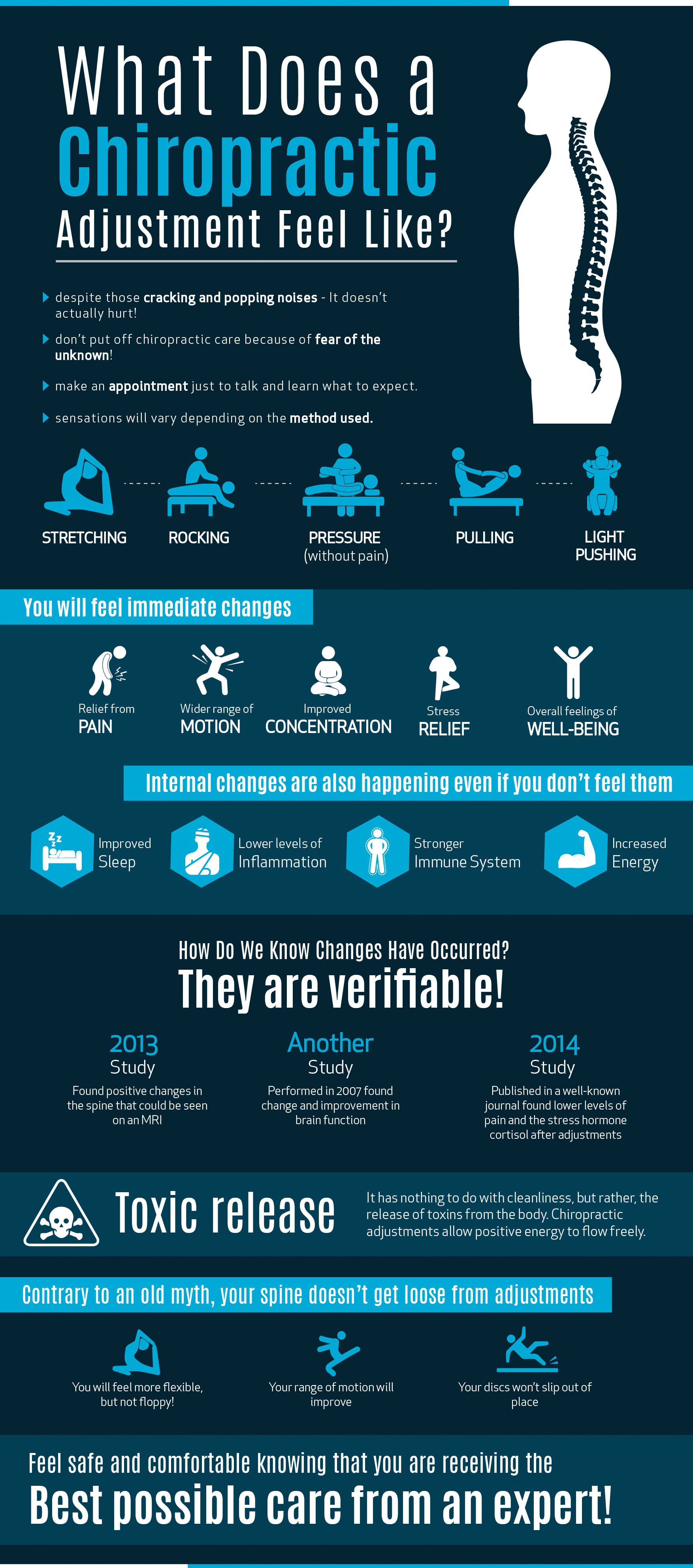Most people have what appears to be an innate fear of doctors, dentists, and even chiropractors. What keeps people from seeing a health care professional?
Is it a fear of having their suspicions confirmed? Or do they fear the intimate closeness of having someone touch their bodies or put their fingers in their mouths? Or is it simply fear of the unknown?
While some might look at their first visit to a chiropractor as an exciting adventure, the truth is that many people are simply afraid of the unknown (what does a chiropractor actually do anyway?) and the possibility of a painful encounter.
Pain is often cited as the main reason most people avoid the dentist. Are you avoiding seeing a chiropractor because you fear that adjustments are painful? How does a chiropractor adjust your back anyway?
Chiropractic work actually began as an alternative to drugs, surgery, or the awful fact that most people simply endure painful joints and back pain!
Chiropractic adjustments offer so many benefits than most people ever dream of! Perhaps the best news of all is that pain isn’t going to be an issue.
If you feel nervous or unsure, we suggest that you make an appointment just to talk. Make a list of all your questions, as well as your physical complaints, and discuss everything. You will feel much better just knowing what to expect!
Just for good measure, if you weren’t aware of it, the Journal of the American Medical Association recommends chiropractic therapies before resorting to anything more invasive.
Speaking of what to expect, we have created a list of 8 of the most unbelievable things most people don’t know about what an adjustment feels like. The more you know, the less apprehensive you will feel!
1) No, Chiropractic Adjustments Don’t Hurt
This is perhaps one of the biggest reasons people avoid going to a chiropractor. The gentle pressure and movements that are done might feel a bit uncomfortable the first visit or two, but nearly everyone who has put off seeing a chiropractor because they fear it will hurt often wishes that they had gone sooner!
If you have ever “cracked” your own back, then you have an idea of what an adjustment will feel like. The sense of relief most people feel is nothing short of astounding. Restoring the alignment of the spine and/or putting joints back into a full range of motion is sometimes described as a feeling of “release”, offering a respite from painful conditions.
In general, adjustments are painless; however, they might feel slightly uncomfortable for a moment, depending on the amount of tension or inflammation in the area being worked on.
Some patients state that, afterward, the area worked on feels tender or slightly sore, but these types of feelings are considered normal, especially in the beginning, and are not associated with feelings of pain.
You might also feel a bit dizzy after a chiropractic adjustment, but that is also a short term, normal side effect.
While every person’s body is different and everyone reacts a bit differently, you can rest assured that this well-established study of chiropractic medicine will do you a great deal of good, with only minimal soreness to show for the effort.
2) Yes, You Will Probably Hear Some Popping or Cracking Noises
Occasionally, two opposing forces in a joint get “stuck” together. Perhaps “suction” would be a better mental image. If you have ever used a suction cup to stick something to a mirror or a piece of glass, you tried to pull it off and heard that popping sound, then you have an idea of what happens to joints during an adjustment.
When any joint in your body is adjusted, what you are actually hearing is the vacuum sound of gas being released inside the fluid that is found in every joint. It might sound like bones are being cracked or broken, but that’s not what is really going on.
This doesn’t mean that every adjustment will make sounds that you can hear. There are plenty of techniques that a chiropractor uses that produce no audible sounds.
Some people feel that if they don’t hear any noise, the adjustment wasn’t successful. This is simply a misunderstanding in how the process works.
Some adjustments are low force and don’t cause sound. Other times, the joint simply doesn’t have a buildup of gas, which also means it won’t cause a sound. Sound is not an indicator of “a job well done”.
Think about breathing as a case in point. You might not hear the person next to you breathing, but the chances that they are breathing are pretty good, right? (At least we hope so!) Now if they run up and down a flight of stairs, you would definitely hear them breathing!
You might feel a bit uneasy if you hear popping sounds if your neck is adjusted, but there is evidence that neck adjustment is safe.
While it is very common for people to hear cracking or popping noises when adjustments are done, this doesn’t always happen and it doesn’t mean that the adjustment was not successful if you don’t hear any sound.
3) You Will Feel Changes Almost Instantly
Depending on how long a problem has been going on and how severe the issue is, the fact is that almost everyone feels an improvement immediately after an adjustment.
If the condition has gone untreated for quite some period of time, some patients feel relief at the onset, but later feel “a bit off”. This is because their bodies have become accustomed to being out of alignment, so the new posture feels strange to them.
Responses to adjustments can vary, but almost everyone feels some sort of change, almost all of them positive. You will most likely notice more flexibility in certain areas, as well as more relaxed and balanced.
If you feel tired as if you just finished a heavy workout at the gym, that is to be expected! You did, in a sense; work on muscles that have been stuck in an improper position for probably quite a while. Moving muscles back into their proper position IS work, so these feelings are normal and pass quickly.
A JMPT study done in 2013 found that adjustment of the spine relieved muscle pain immediately. Not shortly afterwards, but immediately! Those are real results!
We should add that while feelings of relief or lack of pain are normal, they may not last, especially not after just one adjustment. It generally takes several treatments for the spine and muscles to return to their proper alignment.
If you are thinking that “several adjustments” means that you have to go on seeing your chiropractor forever; that’s just an old internet myth. While you might end up feeling so good that you will WANT to keep going, the truth is that, once your symptoms have disappeared, you are pain-free, and proper range of motion has been restored- you are finished!
Much like the dentist, you should set up periodic appointments to make sure everything is still in good working order, but otherwise, don’t consider your chiropractor a lifelong commitment.
4) There are Internal Changes That You Might Not Feel
Although most patients feel an immediate sense of release and improved well-being, some patients say that they don’t feel anything different after being adjusted.
Even if there are no outward signs, there are still internal changes happening within the body. When the normal flow of energy is restored and the brain is able to communicate freely with the internal organs once again, as well as the brain itself receiving signals freely, while it takes some time, you will notice changes in how you feel.
Studies have found that adjustments activate the central nervous system in the body, which affects areas other than those which were intended to be treated.
In the study listed above, for example, it was found that the thalamus, which plays a very important part in our sleep and wake patterns, was stimulated by chiropractic adjustments, even though this was not the original complaint or target of the therapy.
Adjustments are also designed to relieve inflammation, as well as reducing stress and improving the immune system. While you might actually feel some relief from stress, we doubt you will feel your immune system becoming stronger, even though it is!
When you think about the millions of cells, hormones, not to mention your internal organs, that are all controlled by your central nervous system, you can understand how changes can occur internally that you may not feel right away but are actually happening.
5) These Changes Are Verifiable

Because some changes that take place during an adjustment cannot be felt or seen, how can we know for certain that the adjustment was successful?
- A randomized controlled study published in the Journal of Manipulative and Physiological Therapies In 2013 found that actual changes in a subject’s spine were seen on an MRI, even though some patients stated that they felt little or no changes.
- Clinical Neurophysiology published a study in 2007 which found that Chiropractic adjustments actually improve and change the health of the body overall by improving brain function.
- The Journal of Orthopedic and Sports Physical Therapy published a study in 2014 which found lower levels of cortisol (a stress hormone), as well as improved sleep patterns and lower levels of pain, were found in subjects who underwent chiropractic adjustments.
Unfortunately, too many people today turn to pain relievers or energy drinks to find relief from painful body postures or to relieve stress. These can lead to serious addictions; sleep problems, low energy from lack of sleep, and weight gain from high levels of cortisol.
If you pay attention to your body after adjustments, you will notice subtle changes in several areas, including improved cognitive function, improved performance in exercise or sports due to increased mobility, as well as improved energy levels.
6) Toxic Release After Chiropractic Adjustment
One of the topics that many people don’t talk about is that, soon after your first adjustment, you might feel as if you have a slight cold or flu virus taking hold.
This has nothing to do with the sanitation of the office but results from something which is often referred to as “toxic release” after an adjustment.
Approximately 18-20 percent of first-time chiropractic patients experience these types of symptoms. While this might sound off-putting (seriously, who wants a cold, even a minor one?!) the fact is that this actually a good sign.
The release of toxins from the body means that the body is healing. The same way that a scab, while ugly, protects the surface underneath until new skin grows toxic release is a similar sign that your body is on the mend!
What types of symptoms are common with the toxic release? You might (or might not) experience any of the following:
- Fatigue
- Light headaches
- Diarrhea
- Night sweats
- Runny nose
- Stuffed up nose

How long does toxic release after a chiropractic adjustment? These symptoms are nothing to worry about and will pass quickly. Your body is simply adjusting to its new and improved alignment, as well as its improved flow of energy.
Any minor discomfort you might feel as a result of your first adjustment will be well worth the trouble!
7) No, Your Spine Won’t Feel Loose

Some people think that getting adjustments will make their spine “too loose” or that it will feel wobbly after an adjustment.
A chiropractor will only adjust the parts of the spine that are experiencing difficulty or that are out of place.
While it is true that your spine will be flexible afterward, “loose” is not actually the correct word for how it will feel. You will not feel unstable nor will your spine or discs “slip” out of position after an adjustment.
Once adjustments have been performed, most people will tell you that their pain has been relieved and they have a genuine sense of well-being. If adjustments did not work or did not feel good, no one would return to complete their care regimen!
Pain is one of the body’s ways of letting you know that something is not right. Pain should never be considered normal or even a normal part of aging.
If you feel pain in any part of the body, chances are that the spine and central nervous system are involved. Of course, if the chiropractor finds that you have a problem unrelated to his area of expertise, you will be referred to the appropriate health care doctor or other professional needed for treatment.
Feel comfortable and secure in knowing that you are under the best possible care with a knowledgeable professional with years and years of experience.
How often should you get adjusted? That will depend on the root problem. Your chiropractor will set up a treatment plan designed especially for you.
8) Other Sensations
We’ve talked about how you might hear or feel some cracking or popping noises or the fact that some people feel or hear almost nothing.
There are some other sensations that can come into play, however, depending on the type of technique the chiropractor decides to use.
Rather than pushing on the back, your professional might employ low force or even non-force techniques. These can feel more like stretching, pulling, rocking motions, or even simply feelings of pressure.
Adjustments do not always involve the popping and cracking that most people associate with a chiropractor. Sometimes, nothing more is needed than a gentle kneading of the locked joint or even just a simple massage to loosen the muscles that are holding the joint in an improper position.
Almost all adjustments are done on a chiropractic table, where you can lie either face down or face up, depending on what area needs to be worked on. On occasion, adjustments are done while sitting up or even standing up, but this isn’t often the case.
While it is not uncommon for a chiropractor to examine the spine while sitting on the chiropractic table, most adjustments are done while lying down.
Oh, and don’t worry, you don’t have to get undressed!
As we mentioned previously, one of the sensations, most people feel immediately after an adjustment is a relief. Another feeling most people talk about after their first adjustment is amazement.
This is because most people put up with pain or stiff joints for long periods of time, weeks, months, even decades, employing other types of therapy or just using pain medication in an attempt to find relief from their symptoms.
On average, an initial visit lasts approximately 30 minutes, most of this time being spent doing diagnostic work. The adjustment itself, depending on how many and where the adjustments are going to be done, takes only minutes.
So imagine spending years with a painful shoulder or lower back condition, then spending less than an hour getting an adjustment and finding yourself pain-free?!
Most people call this amazing or sometimes, they even call it a miracle.
The Bottom Line
In short, an adjustment does not hurt and doesn’t always make those popping or cracking noises.
There are several types of adjustments that involve feelings such as pulling, stretching, pushing, rocking, or simply pressure.
You should feel a huge sense of relief and well-being after being adjusted. Remember that improved health and performance begins with a healthy, well-aligned spine and free moving joints!
Just a note here about those “self-adjustment” videos you find on social media sites and YouTube. While you can learn some terrific skills from some of these self-help videos, we wouldn’t recommend performing surgery, dental work, or chiropractic adjustments after watching a video. Chiropractors and other health professionals spend many years going to school and keeping their skills updated to perform the delicate work that your body requires.
Don’t trust your back and central nervous system to a video. Always consult with a trained chiropractor. Visit us and get chiropractic adjustment from the most trusted Anchorage chiropractor!









